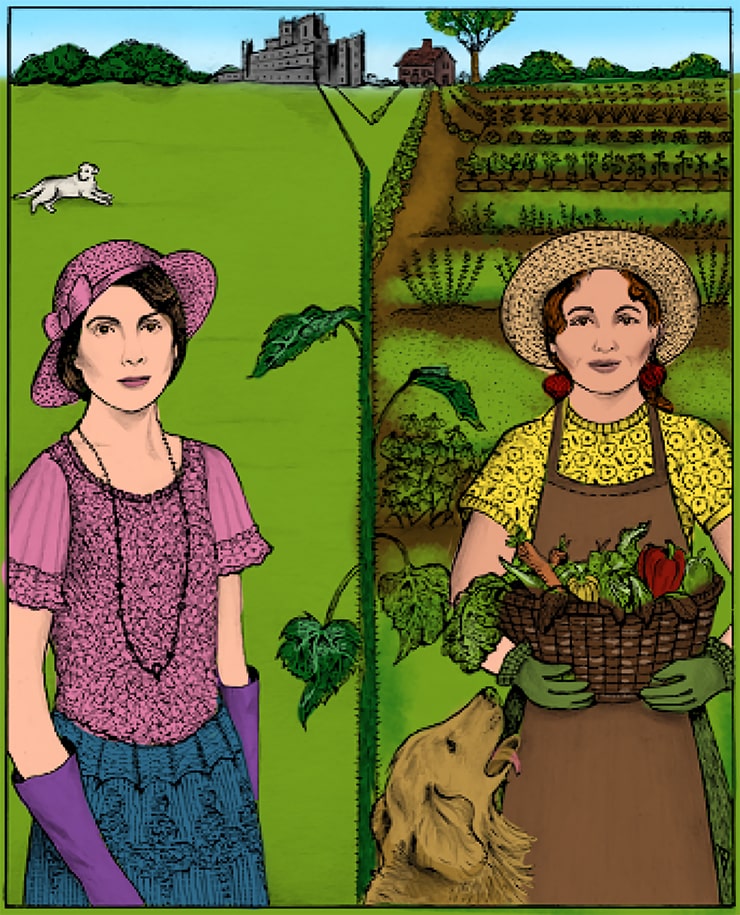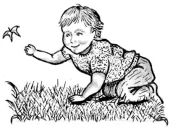Read by Matilda Longbottom

I love Downton Abbey. I’m willing to put up with all its foibles—the lackluster Lady Edith; the snippy Lady Mary; the continual arrests of one or the other of the Bateses; Thomas, the conniving footman—just so I can get a glimpse of aristocratic British country life in the early 20th century. There’s something irresistible about watching people who never wear jeans and have valets to help them button their suspenders.
What continually fascinates me, though, is the Downton lawn. Apparently there are miles of it. Who cuts it? you can’t help but wonder. Housemaids with scissors?
The American lawn obsession—and you know we have one; just listen to the Saturday morning drone of the riding lawn-mowers—is all the fault of the British aristocracy. Lawns first became popular among rich European landowners in the 1700s. In England, under the auspices of landscape gardener Lancelot (nicknamed “Capability”) Brown, estate after estate adopted the idea of the “natural garden”—that is, artfully designed panoramas of trees, ponds, and vast expanses of rolling lawn. Highclere Castle—the model for Downton Abbey—is surrounded by 1000 acres of lawn, put in place in the 1770s for the first Earl of Carnarvon by Capability himself.
The lawn in America got off to a distinctly rocky start. In the first place, there were no native perennial grasses; 17th-century supply lists for wannabe Colonists urged people to stock up on grass and clover seed. The stuff we now (repeatedly) mow is a medley of foreign imports. Even the famed Kentucky bluegrass doesn’t come from Kentucky; it’s a native of Europe and the Middle East.
And, in the second place, the average early Colonist wasn’t about to fool around with maintaining a lawn. Though George Washington referred to the field below his bowling green as a “lawn” at Mount Vernon, and Thomas Jefferson created a European-style lawn at Monticello, lawns—the tidy plots on which modern homeowners set up their croquet hoops and badminton nets—didn’t really become popular in America until after the Civil War. Charles Dickens, touring the country in 1842, sneered at our lawnlessness, pointing out that, in lieu of the “well-trimmed lawns and green meadows of home,” slovenly Americans had only “rank, rough, and wild” tufts of weeds.
The prime proponent of the American lawn seems to have been Frederick Law Olmstead, the landscape architect who designed New York City’s Central Park. In 1868, Olmstead, a pioneer in the art of suburban planning, created a plan for the community of Riverside, Illinois, that featured rows of houses set thirty feet back from the sidewalk, fronted by lawns. Olmstead’s grassy suburbia soon became the standard for the American neighborhood; by the 1940s, when Levitt & Sons, Inc., began erecting their monolithic Levittowns, each of their 17,000 mass-produced houses came equipped with a lawn.
“A smooth, closely shaven surface of grass is by far the most essential element of beauty on the grounds of a suburban house,” one landscaper wrote. “Let your lawn be your home’s velvet robe, and your flowers its not too promiscuous decoration.”
Today the United States has over 40 million acres of lawns—a number calculated using satellite data from NASA, which means that our lawns are now so extensive they’re visible from space. And we spend an ungodly amount of time, energy, and resources taking care of them. Lawn care support is now a multibillion-dollar industry.
As it turns out, though, the care we give our grass isn’t necessarily the best choice for people or the planet. Lawns suck up an immense amount of water (collectively, according to one guess, 200 gallons per person per day); we drench them in chemical fertilizers and weedkillers; and we mow them with gas-powered mowers which, hour for hour, pump out eleven times more air pollutants than the average car.
Rats, I thought when I read that.
I’ve always like mowing the lawn. I like being outside on the tractor, going around in pleasantly mindless circles. It’s a meditative, alpha-wave-generating sort of activity, and cut grass smells good.
The more I think about it, though, the more I’ve become convinced that lawns as we now pander to them aren’t such a good idea. A lot of people have proposed more environmentally congenial alternatives. Better for beleaguered birds, bees, and wildlife, most agree, is to stop mowing altogether and let the lawn revert to natural thicket (a practice sometimes known as “ungardening”)—or, rather than grass, some propose filling the space ordinarily allotted to lawn with native wildflowers and trees. If you don’t want to give up your lawn altogether, some biologists suggest adding occasional patches of weeds and flowering plants as “grass companions” to tempt pollinators.
Or you could turn the whole thing over to food. Artist and gardener Fritz Haeg, the author of Edible Estates: Attack on the Front Lawn (2010) points out that we’d all be better off if we planted more vegetables and less grass. According to one estimate, digging up just 10% of America’s lawns to make room for more tomatoes, lettuce, peppers, and pumpkins could meet up to a third of the country’s current vegetable needs. Heather Flores, in Food Not Lawns (2006), calculates that the average suburban lawn, if turned into wall-to-wall vegetable garden, could turn out several hundred pounds of fruits and vegetables every year.
Still, there are nice things about lawns. A lawn, writes Katharine White in her now-classic Onward and Upward in the Garden, provides a “soft mattress for a creeping baby; worm hatchery for a robin; croquet or badminton court; baseball diamond; restful green perspectives leading the eye to a background of flower border, shrubs, or hedges…” And you can roll on them, run around barefoot on them, or lie on a blanket on them and stargaze.

So no, I don’t want to lose the lawn altogether. Instead, we’re going to add more vegetable plots, encourage wildflower patches, and mow a little less.
And make room for a little bit of bird-friendly thicket. ❖


 Previous
Previous


